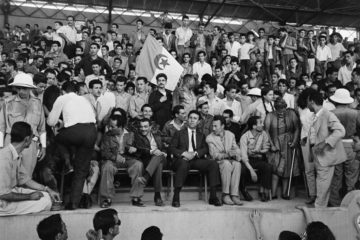
Hall Greenland in Jacobin:
There is a famous concluding scene to Gillo Pontecorvo’s classic 1966 film The Battle of Algiers. After witnessing the French paratroopers “win” the battle by a combination of torture and murder over the previous hour and a half, the film climaxes with the residents of the Casbah surging out into the city with their rebel flags and banners blowing in the wind proclaiming independence and freedom for Algeria.
This was no sop to those of us who like a Hollywood-type happy ending but historical truth. Despite the rout in 1957 of the pro-independence Front de Libération Nationale (FLN) in the actual battle of Algiers, the people themselves went on organizing.
When the French president Charles de Gaulle made his visit to Algeria in December 1960, the people of Algiers and half a dozen other cities throughout the country exploded into mass manifestations to impress on him their unbreakable determination to be free.
It was not the last spontaneous intervention of ordinary Algerians in the fate of their country. When independence came in 1962, most of the million European settlers decided to emigrate rather than live under Algerian rule. They left the country bereft of doctors, engineers, technicians, and teachers.
They also left behind them a trail of destruction. It was not only the terrorist OAS (Secret Army Organization) which wreaked this vengeance, killing thousands of unarmed Algerians. Farmers and businessmen also destroyed machinery and wrecked buildings as they departed.
The abandonment and destruction of the settler farms meant that Algeria faced starvation as the settlers had appropriated the best land. In addition, the French counterinsurgency had forced more than two million Algerians off the land as vast swathes of the countryside were cleared of villages and farms for free-fire zones.
Into this impending famine stepped the hundreds of thousands of Algerian farm workers who took over the abandoned farms and managed them themselves.
More here.
